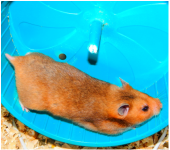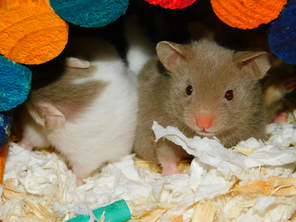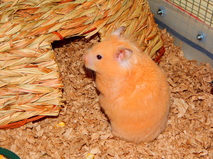
Housing Your Hamster
We recommend that a Syrian hamster habitat be a minimum of 450 square inches of floor space. The bigger the home the hamster is housed in, the happier the hamster will be. In the wild hamsters run for many miles every night. Hamsters will not be happy or healthy in a small cage.
A great choice for hamster homes are homemade bin cages, which is our favorite. Videos on how to build a bin cage can be found online. Cage bins are inexpensive, easy to make, and simple to clean. You can also make bi-level or tri-level bin cage. There are a lot of fun ideas that can be found online.
A 40 gallon breeder or larger glass-tank is an excellent choice. The standard aquarium cover will need to be replaced. The ideal cover should be constructed of a wide wire mesh for good air circulation. Glass tanks are around the same price as the traditional wire hamster cage, but provide much more room for your hamster.
Some other good choices would be DIY Ikea Detolf, 50 gallon Sterilite Stacker Bin, Critter Nation cages, Pervue Hamster Cage, Lixit Animal Care Savic Mickey or Lixit Animal Care Savic Hamster Heaven Metro cage.
We do NOT recommend the use of modular hamster homes that have attachable tubing. There is just not enough space for the hamster to crawl around in even with the tubes. Hamsters tend to get skittish in these types of homes and hamsters tend to refuse to to come out of the tubes when you want to handle them.
One really important thing to remember, Syrian hamsters are sociable creatures, but they must be kept solitary. This is very important because hamsters are territorial by nature and will fight if kept with a cage mate. If you see our hamsters kept in multiples in one cage, that means they are litter mates that are not at the age to be separated yet. We separate all of our adult hamsters into individual cages. Although Syrian hamsters are solitary by nature this does not mean they want to be left alone. A socialized hamster, like ours, thrive on human companionship.
Food and Water
A healthy hamster diet should include lots of variety for proper nutrition. A well balanced diet produced by a great variety of foods ensures the hamsters will grow well and be healthy. You can feed a hamster just prepared food mixes, however we feed our hamsters prepared food mixes along with fresh foods which results in happy hamsters that flourish.
When shopping for prepared food mixes, you will want to check the guaranteed analysis on the bag. A hamsters food should aim for 18% protein, 15% fiber, and <10% fat.
We feed our hamsters Higgins Sunburst seed mix along with Mazuri Rodent Lab Blocks.
We also feed our hamsters fresh fruits and veggies. Here is a sample list of some of the fresh food we offer our hamsters: bean sprouts, broccoli, cauliflower, carrots, sugar snap peas, cucumbers, squash, and apples. All of these foods should be given in small quantities only. A good way to feed fresh foods is to offer a thin slice of apple, a couple of bean sprouts, a small thin slice of carrot, etc. Any uneaten fresh food should be removed from the cage by the next day. The Ontario Hamster Club a full list of safe and unsafe food under their Education Tab.
You can also feed your hamster extra protein in the form of tiny amounts of cooked chicken, scrambled eggs or hard-boiled eggs. Again, the amounts given should be small and any uneaten portion should be removed. Hamsters also relish live or dried meal worms, dried crickets and grasshoppers.
When feeding your hamster any new food, introduce the new foods slowly.
Always provide fresh water for your hamster in a water bottle. Change the water daily to prevent buildup of bacteria and to ensure that the drinking tube isn't clogged. We use 4 Ounce size water bottles. Also, when using a water bottle for the first time, you will want to move around the ball that is on the bottom of the drinking tube around with finger to ensure the water will flow freely.
Floor Covering/Bedding
When looking for floor covering it is best to look for one that is soft and dust free. We use aspen shavings and Boxo Small Animal Bedding (found on Amazon). Other pet bedding brands that are good to use are Carefresh or Kaytee Clean and Cozy which are made out of natural paper. Pine and cedar bedding should not be used. The floor covering in your hamsters cage should be approximately 3-4 inches deep over the floor of the cage. Never use newspaper as floor coverings. Newsprint can contain substances that may be harmful to your hamster if they decide to shred the newspaper for bedding material.
Both male and females hamsters naturally make nests to sleep in. We do not recommend the fluffy wool or cotton bedding for nest making. Fluffy bedding can be very harmful for hamsters. We provide toilet paper or tissue for our hamsters to use for nesting material. Hamsters also like hideaways to make their nests in.
Wheels and Toys
Hamsters need lots of exercise. We highly recommend either an 10" or 12" wheel. If you see your hamster's back arching while it runs on the wheel, it needs a larger wheel. Solid plastic wheels are what we recommend. It is best not to use wire wheels. The hamsters hair or limbs could become trapped in the wire wheels. Some good type of wheels you want to look for are: comfort wheels, silent spinners, bucket wheels or Wodent wheels.
A hamsters teeth never stop growing, and without objects to gnaw on they can grow too long. You will want to provide your hamster with wooden toys to keep them in good shape. Rodent lab blocks or crunchy snacks also will help keep your hamsters teeth trimmed.
Remember not to overcrowd your hamsters home with too many toys. Make sure to leave enough room for the hamster to exercise and burrow.
Life Span
The average life span of the Syrian hamster is around 18 months to 2 years.
Miscellaneous Helpful Tips
It is important to wash your hands before picking up hamsters. Hamsters have a great sense of smell. If the scent of another hamster or the scent of food is on your hands they might try to nibble at your hands. Be sure to wash with unscented soap.
Never wake your hamster suddenly from sleep. Hamsters sleep very deeply. If they are suddenly disturbed, it is their natural instinct to be on defense. To wake your hamster, speak to it in a soft voice.
When picking up your hamster, always pick up with both hands. Let the hamster see your hands first, talk to it softly. Put one hand under its bottom and scoop up from underneath. Always lift the hamster facing toward you.
If you are re-using a cage from a pet shop hamster that was sick or had wet tail, it is very important that the home from the sick hamster is thoroughly sanitized before introducing a new hamster to the home. It is best to dispose of the old water bottle, food, bedding, etc. that was in contact with the sick hamster. Immerse everything else in a hot bleach bath.
The best room temperature to keep your hamster in is 65-75 degrees Fahrenheit. If the room temperature goes below 60 degrees, the hamster can go into hibernation, which is very dangerous for them.
We recommend that a Syrian hamster habitat be a minimum of 450 square inches of floor space. The bigger the home the hamster is housed in, the happier the hamster will be. In the wild hamsters run for many miles every night. Hamsters will not be happy or healthy in a small cage.
A great choice for hamster homes are homemade bin cages, which is our favorite. Videos on how to build a bin cage can be found online. Cage bins are inexpensive, easy to make, and simple to clean. You can also make bi-level or tri-level bin cage. There are a lot of fun ideas that can be found online.
A 40 gallon breeder or larger glass-tank is an excellent choice. The standard aquarium cover will need to be replaced. The ideal cover should be constructed of a wide wire mesh for good air circulation. Glass tanks are around the same price as the traditional wire hamster cage, but provide much more room for your hamster.
Some other good choices would be DIY Ikea Detolf, 50 gallon Sterilite Stacker Bin, Critter Nation cages, Pervue Hamster Cage, Lixit Animal Care Savic Mickey or Lixit Animal Care Savic Hamster Heaven Metro cage.
We do NOT recommend the use of modular hamster homes that have attachable tubing. There is just not enough space for the hamster to crawl around in even with the tubes. Hamsters tend to get skittish in these types of homes and hamsters tend to refuse to to come out of the tubes when you want to handle them.
One really important thing to remember, Syrian hamsters are sociable creatures, but they must be kept solitary. This is very important because hamsters are territorial by nature and will fight if kept with a cage mate. If you see our hamsters kept in multiples in one cage, that means they are litter mates that are not at the age to be separated yet. We separate all of our adult hamsters into individual cages. Although Syrian hamsters are solitary by nature this does not mean they want to be left alone. A socialized hamster, like ours, thrive on human companionship.
Food and Water
A healthy hamster diet should include lots of variety for proper nutrition. A well balanced diet produced by a great variety of foods ensures the hamsters will grow well and be healthy. You can feed a hamster just prepared food mixes, however we feed our hamsters prepared food mixes along with fresh foods which results in happy hamsters that flourish.
When shopping for prepared food mixes, you will want to check the guaranteed analysis on the bag. A hamsters food should aim for 18% protein, 15% fiber, and <10% fat.
We feed our hamsters Higgins Sunburst seed mix along with Mazuri Rodent Lab Blocks.
We also feed our hamsters fresh fruits and veggies. Here is a sample list of some of the fresh food we offer our hamsters: bean sprouts, broccoli, cauliflower, carrots, sugar snap peas, cucumbers, squash, and apples. All of these foods should be given in small quantities only. A good way to feed fresh foods is to offer a thin slice of apple, a couple of bean sprouts, a small thin slice of carrot, etc. Any uneaten fresh food should be removed from the cage by the next day. The Ontario Hamster Club a full list of safe and unsafe food under their Education Tab.
You can also feed your hamster extra protein in the form of tiny amounts of cooked chicken, scrambled eggs or hard-boiled eggs. Again, the amounts given should be small and any uneaten portion should be removed. Hamsters also relish live or dried meal worms, dried crickets and grasshoppers.
When feeding your hamster any new food, introduce the new foods slowly.
Always provide fresh water for your hamster in a water bottle. Change the water daily to prevent buildup of bacteria and to ensure that the drinking tube isn't clogged. We use 4 Ounce size water bottles. Also, when using a water bottle for the first time, you will want to move around the ball that is on the bottom of the drinking tube around with finger to ensure the water will flow freely.
Floor Covering/Bedding
When looking for floor covering it is best to look for one that is soft and dust free. We use aspen shavings and Boxo Small Animal Bedding (found on Amazon). Other pet bedding brands that are good to use are Carefresh or Kaytee Clean and Cozy which are made out of natural paper. Pine and cedar bedding should not be used. The floor covering in your hamsters cage should be approximately 3-4 inches deep over the floor of the cage. Never use newspaper as floor coverings. Newsprint can contain substances that may be harmful to your hamster if they decide to shred the newspaper for bedding material.
Both male and females hamsters naturally make nests to sleep in. We do not recommend the fluffy wool or cotton bedding for nest making. Fluffy bedding can be very harmful for hamsters. We provide toilet paper or tissue for our hamsters to use for nesting material. Hamsters also like hideaways to make their nests in.
Wheels and Toys
Hamsters need lots of exercise. We highly recommend either an 10" or 12" wheel. If you see your hamster's back arching while it runs on the wheel, it needs a larger wheel. Solid plastic wheels are what we recommend. It is best not to use wire wheels. The hamsters hair or limbs could become trapped in the wire wheels. Some good type of wheels you want to look for are: comfort wheels, silent spinners, bucket wheels or Wodent wheels.
A hamsters teeth never stop growing, and without objects to gnaw on they can grow too long. You will want to provide your hamster with wooden toys to keep them in good shape. Rodent lab blocks or crunchy snacks also will help keep your hamsters teeth trimmed.
Remember not to overcrowd your hamsters home with too many toys. Make sure to leave enough room for the hamster to exercise and burrow.
Life Span
The average life span of the Syrian hamster is around 18 months to 2 years.
Miscellaneous Helpful Tips
It is important to wash your hands before picking up hamsters. Hamsters have a great sense of smell. If the scent of another hamster or the scent of food is on your hands they might try to nibble at your hands. Be sure to wash with unscented soap.
Never wake your hamster suddenly from sleep. Hamsters sleep very deeply. If they are suddenly disturbed, it is their natural instinct to be on defense. To wake your hamster, speak to it in a soft voice.
When picking up your hamster, always pick up with both hands. Let the hamster see your hands first, talk to it softly. Put one hand under its bottom and scoop up from underneath. Always lift the hamster facing toward you.
If you are re-using a cage from a pet shop hamster that was sick or had wet tail, it is very important that the home from the sick hamster is thoroughly sanitized before introducing a new hamster to the home. It is best to dispose of the old water bottle, food, bedding, etc. that was in contact with the sick hamster. Immerse everything else in a hot bleach bath.
The best room temperature to keep your hamster in is 65-75 degrees Fahrenheit. If the room temperature goes below 60 degrees, the hamster can go into hibernation, which is very dangerous for them.
Copyright © 2023 Nantucket Hamstery - All Rights Reserved



